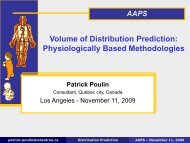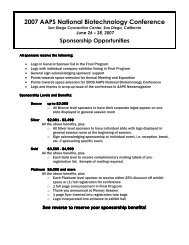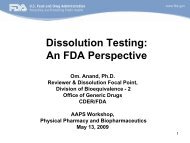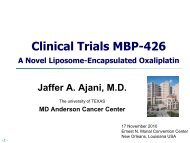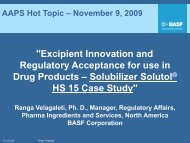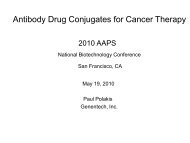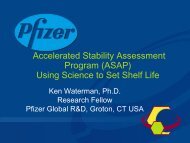Preliminary Program - American Association of Pharmaceutical ...
Preliminary Program - American Association of Pharmaceutical ...
Preliminary Program - American Association of Pharmaceutical ...
You also want an ePaper? Increase the reach of your titles
YUMPU automatically turns print PDFs into web optimized ePapers that Google loves.
66<br />
2009 AAPS Annual Meeting and Exposition<br />
AAPS Pharmacokinetics, Pharmacodynamics and Drug Metabolism (PPDM) <strong>Program</strong>ming<br />
Moderators<br />
Yurong Lai, Ph.D.<br />
Pfizer, Inc.<br />
Marilyn Morris, Ph.D.<br />
University at Buffalo, The State University<br />
<strong>of</strong> New York<br />
Regulation <strong>of</strong> Transporters by Nuclear<br />
Hormone Receptors: Implications During<br />
Inflammation<br />
Micheline Piquette-Miller, Ph.D.<br />
University <strong>of</strong> Toronto<br />
Impact <strong>of</strong> Inflammation on Hepatobiliary<br />
Transporters<br />
Yurong Lai, Ph.D.<br />
Pfizer, Inc.<br />
Drug Interaction Studies <strong>of</strong> Therapeutic<br />
Protein or Monoclonal Antibodies<br />
Iftekhar Mahmood, Ph.D., invited<br />
U.S. Food and Drug Administration<br />
8:00 am – 10:00 am<br />
Optimization <strong>of</strong> Systemic Exposure in<br />
Preclinical and Clinical Development:<br />
“Success Stories” <strong>of</strong> Proven Methods for<br />
Challenging Drug Candidates — What<br />
You Did Not Already Know!<br />
Roundtable<br />
The identification and development <strong>of</strong> new drug<br />
candidates with a desirable systemic exposure<br />
that is both efficacious and safe in humans<br />
with “developable” formulations based on<br />
preclinical data remains a major challenge in the<br />
pharmaceutical sciences. One reason is that oral<br />
systemic exposure is determined by a variety <strong>of</strong><br />
physicochemical and metabolic factors including<br />
drug solubility, permeability, dissolution, dosage<br />
forms, as well as, first-pass, transporter effects,<br />
and varying gastrointestinal physiology. Another<br />
reason is that multidisciplinary teams <strong>of</strong>ten cannot<br />
reach consensus which formulation and modeling<br />
approaches can be used with confidence to select<br />
a dosage form for first in human studies. Thus,<br />
science driven strategies to determine the systemic<br />
exposure rate limits will be presented based on new<br />
compounds and new data. Correct analysis <strong>of</strong> factors<br />
controlling exposure for drugs <strong>of</strong> all BCS classes.<br />
When low exposure is seen, there can be the<br />
incorrect perception that formulation improvement<br />
works for every compound. In other cases, controlled<br />
release formulations should be attempted to<br />
optimize the PK pr<strong>of</strong>iles. Modeling and simulation<br />
are also meaningful tools in designing PK/<br />
formulation/ADME/TK studies, as well as, species<br />
scaling to human. Specific formulation strategies,<br />
and proven modeling approaches that can be used<br />
when facing different BCS classification compounds<br />
will be shared. In addition, the role <strong>of</strong> transporters<br />
in drug disposition with a focus on BCS Class II-IV<br />
drugs will be discussed, as well as, science-driven<br />
optimization <strong>of</strong> formulation selection studies for<br />
clinical trials and final marketing formulations.<br />
Moderators<br />
Tycho Heimbach, Ph.D., M.S.<br />
Novartis<br />
Hyo-Kyung Han, Ph.D.<br />
Chosun University<br />
Successful Methods for Systemic Exposure<br />
Optimization: IVIVC and Proven Formulation<br />
Strategies to Predict Clinical and Preclinical<br />
Outcome for Drugs <strong>of</strong> All BCS Classes<br />
Handan He, Ph.D.<br />
Novartis<br />
Systemic Exposure and Oral Absorption<br />
Assessment <strong>of</strong> Poorly Water-soluble Drugs in<br />
the Fasted and Fed State to Predict Clinical<br />
Outcome<br />
Makoto Kataoka, Ph.D.<br />
Setsunan University<br />
BDDCS vs. BCS as an Enabling Tool in Drugs<br />
Discovery: Evolving Understandings <strong>of</strong><br />
Disposition for BCS Class II-IV Drugs<br />
Leslie Benet, Ph.D.<br />
University <strong>of</strong> California San Francisco<br />
MONDAY AFTERNOON SYMPOSIA<br />
Funded by a Grant from<br />
2:00 pm – 4:30 pm<br />
AAPS/ACCP Joint Symposium: Strategic<br />
Biomarkers for Treating Diseases in<br />
Younger Children Safely and Effectively<br />
Symposium<br />
Recent implementation <strong>of</strong> removing children<br />
(ages 0-4) from the labels <strong>of</strong> various OTC coldrelief<br />
medicines is due to a finding that there<br />
have been more adverse events in this age group.<br />
Pediatric patients are a vulnerable population<br />
that needs special attention to the efficacy and<br />
safety <strong>of</strong> medicines administered. What are the<br />
biomarkers for extrapolating adult doses for<br />
younger children (age 0-4)? Is the body-weight<br />
based approach reasonable? What biomarkers<br />
(ontogenic development <strong>of</strong> phase I and phase<br />
III metabolizing enzymes) should we explore? Is<br />
systemic exposure <strong>of</strong> drug a reliable biomarker for<br />
selecting pediatric dose and predicting adverse<br />
events in younger children? What is known about<br />
the difference between adults and younger children<br />
<strong>of</strong> this age group in terms <strong>of</strong> the pharmacological<br />
and pharmacodynamic responses? This symposium<br />
will have a panel <strong>of</strong> clinical experts and regulatory<br />
authority to discuss dose selection biomarkers<br />
for younger children based on our understanding<br />
<strong>of</strong> drug absorption, ontogenic development <strong>of</strong><br />
metabolizing enzymes, and pharmacological<br />
receptors that affect the efficacy and safety <strong>of</strong><br />
pediatric medical use. The FDA’s pediatric guidance<br />
update and drug-disease interactions in pediatrics<br />
will be discussed as well. Our symposium has been<br />
aligned with the symposium, entitled “Leveraging<br />
Prior Quantitative Knowledge in Guiding Pediatric<br />
Drug Development,” which is scheduled for<br />
2:00 pm – 4:30 pm, November 10, 2009. The goal<br />
<strong>of</strong> our alignment is to give the attendees a complete<br />
overview <strong>of</strong> pediatric drug development.<br />
Moderators<br />
Bernd Meibohm, Ph.D.<br />
University <strong>of</strong> Tennessee Health Science Center<br />
Pei Fan (Jane) Bai, Ph.D.<br />
U.S. Food and Drug Administration<br />
Ontogeny <strong>of</strong> Drug Metabolizing Enzymes and<br />
Transporters: Potential Biomarkers for Drug<br />
Disposition in Newborns and Infants<br />
Bernd Meibohm, Ph.D.<br />
University <strong>of</strong> Tennessee Health Science Center<br />
Predicting Pediatric Doses for Therapeutic<br />
Success via Simulation and Modeling<br />
Jeffrey Barrett, Ph.D.<br />
University <strong>of</strong> Pennsylvania<br />
Experience with Infants and Young Children in<br />
Drug Studies Performed Under BPCA and PREA<br />
Gilbert Burckart, Pharm.D., invited<br />
U.S. Food and Drug Administration<br />
Clinical Biomarkers: Nice to Have or a Clinical<br />
Imperative?<br />
Paul J. Desjardins, D.M.D., Ph.D.<br />
Wyeth Consumer Healthcare<br />
2:00 pm – 4:30 pm<br />
The Modeling and Simulation Frontier:<br />
Multi-level, Multi-scale, Multi-attribute,<br />
Adaptable, and Extensible Discrete<br />
Event Models<br />
Symposium<br />
This session will allow attendees to better<br />
understand how multi-level, multi-scale, multiattribute,<br />
adaptable, and extensible, discrete event<br />
models can be used to advance pharmaceutical<br />
research. Understand the uses and capabilities<br />
<strong>of</strong> different classes <strong>of</strong> models and methods.<br />
Understand how new classes <strong>of</strong> models can help<br />
bridge the gap between current PK/PD models<br />
and the wet-lab, animal, and clinical trial models<br />
on which pharmaceutical research depends.






